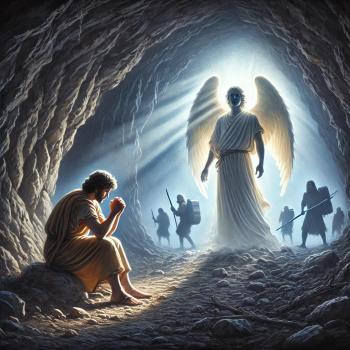Why Does the Resurrection Matter?
There are three important questions about the Resurrection:
- What is the resurrection of Christ?
- What is the evidence that this resurrection occurred?
- Why does the Resurrection important?
We can understand the nature of Christ’s resurrection by comparing it to the raising of Lazarus (John 11:38-44) and the son of the widow of Nain (Luke 7:11-17). These two men were physically dead; Jesus brought them back to life. They did not live forever in the body in which they returned from death. They eventually died physically, and they are physically dead today. The resurrection of Jesus Christ was different. He died physically, but he returned to life. He did not return with the same physical body, but rather, He received a new, glorified body and became the firstfruits of all who have died (1 Corinthians 5:20). He lives today in heaven and will continue to live for eternity. The resurrection of Jesus Christ is the historical event by which He came back from physical death to a new quality of life with a new, glorified body, never again to die.
What is the evidence for this resurrection of Jesus Christ?
First, the New Testament teaches that Jesus Christ was dead physically.
His death occurred after at least three predictions prior to the event (Matthew 16:21, 17:23, 20:17-19). A centurion observed his death and exclaimed, “Truly this man was the Son of God” (Mark 15:39). Other soldiers at the crucifixion observed that He was dead when they attempted to break His legs (John 19:32-27). These professional soldiers possessed the ability to observe and diagnose the presence of death. Joseph of Arimathea received the body of Jesus for burial. If Jesus had been alive, Joseph would have noticed signs of life. Joseph wrapped the body of Jesus in pungent spices which surely would have awakened Jesus if He had only fainted and had not actually died (John 19:39). We can say with confidence that Jesus Christ was dead.
Second, Jesus Christ was buried.
Joseph of Arimathea buried Him in a new cave cut from rock (Matthew 27:57-61). Guards were placed at the tomb under the orders of Pontius Pilate the governor. A seal was placed on the tomb. A heavy stone was rolled in front of the opening. Women followers of Jesus (Matthew 27:61) observed the location of his burial. Jesus was buried in a tomb, and His followers observed the location.
Third, the tomb was empty.
The New Testament explains that an earthquake occurred, an angel descended, and the angel rolled away the stone (Matthew 28:1-2). This incident left the guard detail in a state of paralyzed terror (Matthew 28:4). The angel announced the resurrection to the women who had come to the tomb to complete the process of burial (Matthew 28:5-7). Peter and John raced to the tomb to find it empty (John 20:2-10). The orderliness of the appearance of the burial clothing suggested that no one had stolen Jesus’ body. Instead, the empty tomb and the appearance of the grave clothing within convinced the beloved disciple that Jesus had arisen (John 20:8). The effort by the enemies of Jesus to bribe the guards at the tomb to lie about the disappearance of Jesus’ body provides evidence for the Resurrection (Matthew 28:11-15). These enemies knew surely that some miracle had led to the disappearance of the body. The soldiers guarding the tomb could not possibly describe an incident which allegedly occurred while they slept!
Fourth, the post-Resurrection appearances of Jesus reveal the reality of the Resurrection.
These appearances occurred to many different groups of people, in many places, and at various times. They endured for forty days, suddenly came to an end when Jesus ascended into heaven, and have never occurred since that time. After the Resurrection Jesus appeared to such individuals as Mary Magdalene (John 20:0-18), Peter (Luke 24:34), Thomas (John 20:26-28), and James, the Lord’s brother
(1 Corinthians 15:7). He appeared to such small groups as the Emmaus disciples (Luke 24:13-35), the women as they left the location of the tomb (Matthew 28:8-10), and the seven disciples as they were fishing (John 21:1-14). He also appeared to larger groups such as the entire body of the disciples (John 20:19-23) and a group of over five hundred believers (1 Corinthians 15:6). Moreover, these appearances occurred in different places at different times of the day. The variety of these appearances rules out any possibility that these sightings were mere hallucinations.
Finally, we see evidence for the Resurrection in the changes in the disciples.
One day they were cowering in terror from the Roman authorities, and after Pentecost God changed them into a group that no degree of persecution could muzzle. The single event that contributed to their change was the resurrection of Christ. Only an event such as the Resurrection could lead the Christian Jews to move their day of worship from the Sabbath to Sunday, the day when the Lord rose from the dead. Only a historical event such as the Resurrection could lead Christians to adopt baptism, an event proclaiming Jesus’ resurrection, as the symbol of entrance into the Christian life. All of these features, taken together, provide cumulative certainty of the reality of the Resurrection.
Given that the Resurrection occurred, why is it important?
The Resurrection provides evidence of the deity of Christ (Romans 1:4).
The Resurrection is the event by which Jesus was exalted into heaven (Acts 2:33).
The Resurrection provides a basis for the justification of believers (Romans 4:25).
The fact of Jesus’ resurrection provides confidence for the coming resurrection of all believers (1 Thessalonians 4:14, Romans 8:11).
Because of the Resurrection, all believers have an incentive to endure and persist in Christian living (1 Corinthians 15:58).
The fact of Jesus’ resurrection is the event which has prompted human beings to believe in Jesus as Lord. The Resurrection has led individuals to experience hope for the future and encouragement and help in this life. The Resurrection has placed Christianity in the unique position of having a historical basis for the supernatural faith which it declares.
Photo via Pixabay














